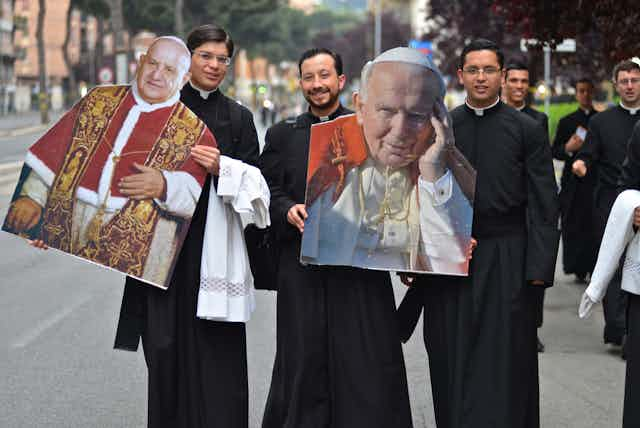Popes John Paul II and John XXIII were declared saints by Pope Francis last Sunday. So what were the “miracles” necessary for John Paul’s sainthood, and how likely was it they really occurred?
Almost 40% of Australians believe in miracles, and the Oxford Dictionary defines a miracle as:
an extraordinary and welcome event that is not explicable by natural or scientific laws and is therefore attributed to a divine agency.
There is a lengthy process to sainthood. While this process has been expedited and adjusted throughout history with papal discretion, it generally follows a uniform course.
The final step in canonisation requires a second miracle, which must be attributed to the candidate saint. For a case to fulfil the criteria for a medical miracle, the healing must be instant and long-lasting.
This decision is made by the Congregation for the Causes of Saints, and requires scientific consultation to explore and exclude alternative explanations. The process is not transparent and the decision is final.

Prior to 1531, canonisation was achieved largely through tradition or martyrdom. This was succeeded by a period where sainthood was achieved by the performance of three miracles.
During his tenure as pope (1978-2005), John Paul II accelerated the process of canonisation by reducing the requirement to just two miracles. Pope Francis waived the requirement of the performance of a second miracle when he declared John XXIII a saint after the late pope had only one miracle attributed to him.
It has been reported that Pope Francis may now be considering the canonisation of Pope Pius XII, in spite of there being no miracles attributed to him.
Miracles over time
A review of 1,400 canonisation miracles over four centuries finds many patterns. More than 95% of miracles were healings from physical illness, with medical miracles accounting for 99% of all miracles in the 20th century.
The diseases addressed by miracles reflect the shifts in disease prevalence in society over time: smallpox and fevers early on, tuberculosis in the 19th century and malignancy, neurological and heart disease in contemporary time.
The first attributed miracle of John Paul II was a cure of Parkinson’s disease in a French nun, Marie Simon-Pierre, in 2005. Here’s part of her account of being healed:
[…] before the Most Blessed Sacrament, I meditated on John Paul II’s Mysteries of Light. At 6 o’clock in the morning, I went out to meet with the sisters in the chapel for a time of prayer, which was followed by the Eucharistic celebration.
I had to walk some 50 metres and at that very moment I realised that, as I walked, my left arm was moving, it was not immobile next to my body. I also felt a physical lightness and agility that I had not felt for a long time.

Sister Simon-Pierre’s purported miracle is problematic in many respects. There have been media reports of her suffering a relapse of her condition and there are doubts about the initial diagnosis. Parkinson’s disease is a clinical diagnosis, and sometimes diagnostic errors occur.
The second attributed miracle involved a claimed cure of a cerebral aneurysm in a Costa Rican woman, Floribeth Mora Diaz, in 2011. While her neurosurgeon claimed he had never read about this occurring before, there are documented cases of spontaneous resolution of cerebral aneurysms in the literature.
Lastly, when tested, intercessory prayer appears to make no difference to the outcome of medical conditions.
We do, rarely, see spontaneous remission of disease in medicine. We don’t understand what causes this spontaneous remission in most cases, but it is not logical or necessary to invoke a supernatural deity to explain this occurrence.
Inexplicable results are a cause to wonder, investigate further, develop hypotheses and test them – to engage with the process of scientific inquiry. This is the process that has resulted in the development of modern medicine – providing successful treatments for Parkinson’s disease and cerebral aneurysms.
What are the odds?
There are many secular and non-secular works examining the concept of miracles. One seminal work is Scottish philosopher David Hume’s An Enquiry Concerning Human Understanding.

He writes that “nothing is esteemed a miracle, if it ever happens in the common course of nature” and “no testimony is sufficient to establish a miracle, unless the testimony be of such a kind, that its falsehood would be more miraculous, than the fact, which it endeavours to establish”.
The prominent English mathematician John Littlewood wrote extensively about the statistics underpinning incidents that were touted as miracles.
He famously suggested that any given individual could statistically expect a “miraculous”, one-in-a-million, event to occur at the rate of approximately once per month.
The wider principle here is that, with a sufficiently large sample size, peculiar and low probability events (including inexplicable occurrences that may be considered miracles) will not be as rare as one may intuitively expect.
Evidence suggests that priming one to use analytical thinking may reduce levels of religious belief.
Perhaps a healthy dose of scepticism and analytical thinking is needed before we accept, on face value, the occurrence of another miracle from the Catholic Church.
See also:
John Paul is no saint – his canonisation is political theatre

